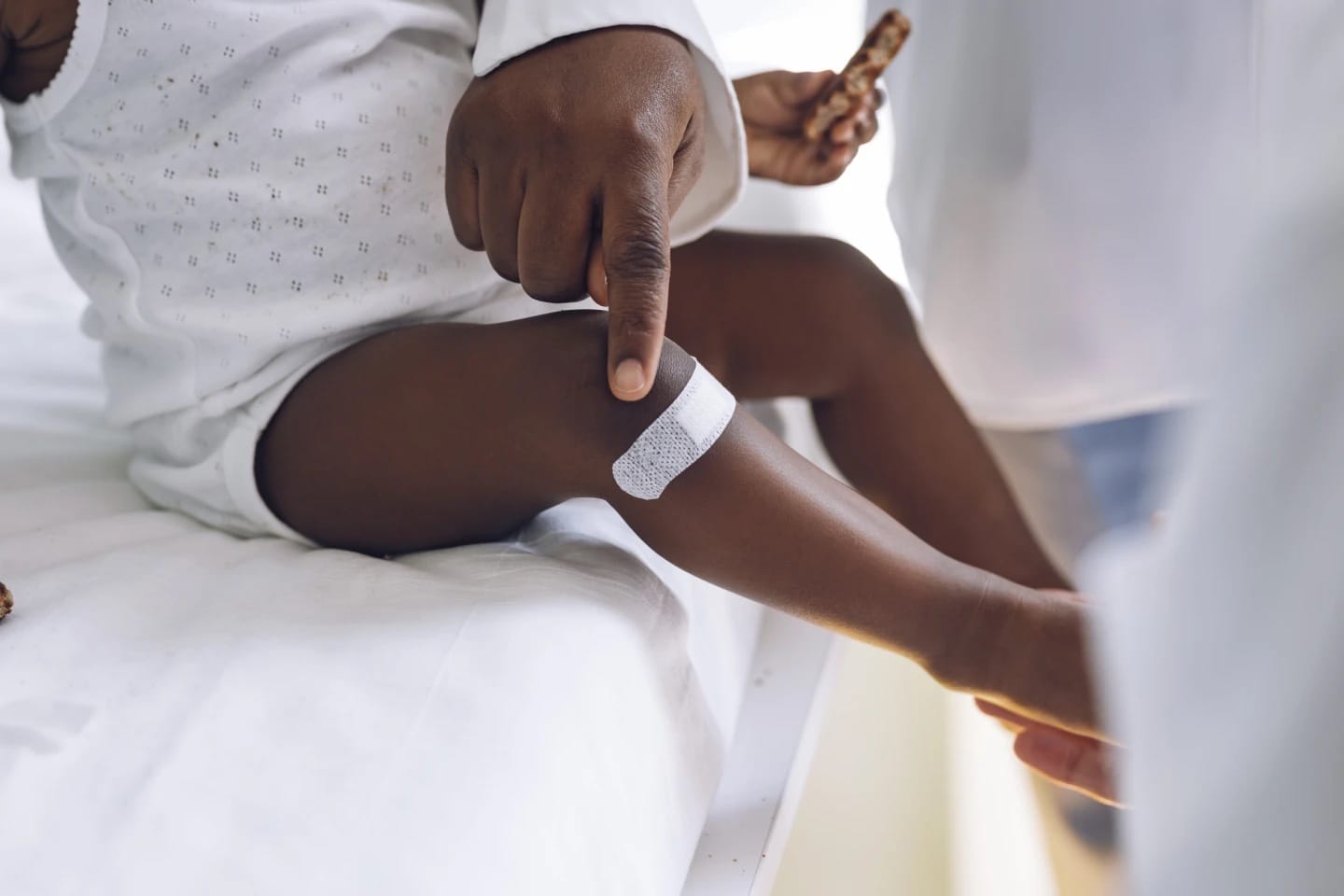Baby first aid: How to treat injuries & when to call the doctor

An expert outlines 7 common injuries in babies and exactly what to do for each.
Table of Contents
It goes without saying that we always want to protect babies and keep them safe. But minor bumps and bruises can and will happen, despite your best intentions: babies can sometimes bonk into household items while crawling, get bug bites and stings or cut themselves before you can intervene. That’s why it’s smart to have some baby first aid basics under your belt, so that you’ll know what to do if and when the need arises.
As part of keeping our babies safe, it’s important for all parents to know when to seek care from your child’s pediatrician or an emergency department—and parents and caregivers should learn infant CPR just in case.
Related: Your 10 most pressing baby safety questions, answered by a pediatrician
7 common injuries in babies and how to manage them
1. Minor cuts and scrapes
A baby on the move can easily get injured if they fall, but minor cuts and scrapes can be managed at home.
First aid for minor cuts and scrapes in babies
Wash with mild soap and water and apply some topical antibiotic ointment such as bacitracin (avoid Neosporin because it can cause an allergic reaction in some). You can leave minor cuts and scrapes open to the air or cover with a bandage for 1 to 3 days.
Related: A parent’s guide to car seat safety: Tips, rules & product picks
2. Splinters
A splinter is a sharp piece of material that gets lodged underneath the skin. Sometimes it is noticed immediately and other times it’s only noticed when it starts causing discomfort over time. A splinter can be removed at home if it is small and visible.
How to remove a splinter in babies
First, clean the area with soap and water. Then use a tweezer sterilized with rubbing alcohol to gently pull it out. Clean the area again and apply ointment, and observe over time for any signs of infection. If the splinter appears deep or you are unable to remove it, call your child’s pediatrician for further recommendations.
3. Bites
No parent loves to hear their child was bitten by another child, but children are active and bites can happen by accident while playing. The good news is that most bites in children are harmless and rarely cause skin breakdown. If your child sustains a bite from a sibling or another child, their need for medical intervention depends on if the skin is broken or not.
How to treat a bite wound:
- If the skin is not broken, clean with mild soap and water
- If the skin is broken and bleeding, allow for slight bleeding then control bleeding (as discussed above). Clean with mild soap and water. In most cases of bites from children, this is enough for wound care
- Antibiotics may be needed depending on the depth and location of the bite injury
- Confirm your child’s tetanus immunization status
- Speak to your child’s pediatrician if there is concern
Related: 50 important child safety tips every parent needs to know
4. Insect bites and bee stings
Insect bites and bee stings are common when babies and children are outside. If your child gets stung by a bee, stay calm and leave the area immediately, and if possible, go inside.
First aid for insect bites and stings
Most bee stings leave a stinger, so remove this as soon as possible with a tissue or gauze (avoid tweezers, because squeezing the stinger may release venom). Wash the area with mild soap and water, and apply ice (be sure ice is wrapped in a cloth to protect the skin from cold burn).
Your child should be taken to the emergency room if they develop signs of anaphylaxis (severe allergic reactions) such as swelling of the face or lips, vomiting, difficulty breathing or wheezing.
5. Nosebleeds
Nosebleeds are common in children and can be scary for caregivers to witness. The good news is that most nosebleeds in children are minor and easily managed at home.
How to treat a nosebleed in babies
If your child gets a nosebleed, have them sit down and lean forward. If they are too young to sit alone, place them on your lap and lean them forward. Using your thumb and index finger, pinch the soft part of the nose, at the bottom of the nostrils, firmly and steadily for about 10 to 15 minutes. They can breathe through their mouth while you do this.
Call your pediatrician or go to the emergency room if bleeding persists for more than 15 minutes or your child is on blood thinners or medications that can cause bleeding.
Related: 14 science-backed ways to reduce SIDS risk in babies
6. Burns
Warm drinks and foods are comforting on cool days, but they should be handled with care around babies and infants—your stroller’s cup holder is actually not a safe place for a cup of hot coffee, even with a lid (unless it’s a secure traveler’s cup with a leak-proof, screw-top lid). Keep babies out of the kitchen when cooking. And when hot foods are outside the kitchen, remember to place them above the ground because babies who are mobile can easily reach them out of curiosity and sustain a burn.
How to treat burn injuries in children at home
If your child sustains a burn, the care they need depends on the severity and location of the burn. Immediately after a burn, take them to a safe place and cool the burn with cool or lukewarm water (please avoid ice). You should call your pediatrician to evaluate the burn and decide if home care is appropriate or evaluation in the emergency department is needed. Some burns may look mild, but burns involving the face, ears, hands, feet or groin and burns that cross the joint need to be evaluated for proper care.
7. Bleeding
Some parts of the human body have a lot of blood vessels and bleed easily even with minor injuries—anywhere in the mouth, for example. If your baby gets an injury that starts bleeding, it’s easy to get overwhelmed by the sight of blood.
First aid to control bleeding in babies
The first step is to try to stay calm; then place a gauze or cloth over the wound and apply steady pressure for at least 5 minutes to help control bleeding. If bleeding persists for about 5 to 10 minutes after steady pressure, call your doctor for further recommendations.
When to get medical care
When injuries happen, it’s easy to be too overwhelmed to estimate what type of care a child needs. The first step is to stay calm and reassure your child. Start with first aid as recommended and call your child’s pediatrician for recommendations.
Injuries that require immediate call to 911 include but are not limited to:
- A serious burn
- Burn to the face
- Injuries leading to an unconscious child
- Persistent uncontrollable bleeding
- Signs of anaphylaxis: swelling of the face or lips, vomiting, difficulty breathing or wheezing
Keep the number of the poison control center (PCC): 800-222-1222 in your phone contacts as well, and use it if you suspect your baby has ingested something harmful.
A version of this story was originally published on Oct. 6. 2020. It has been updated.


































